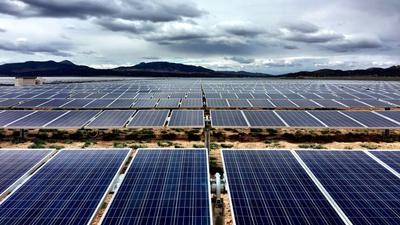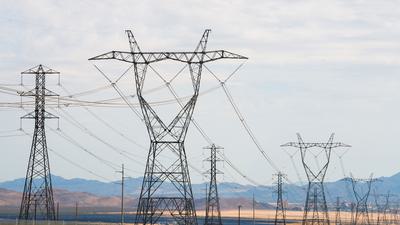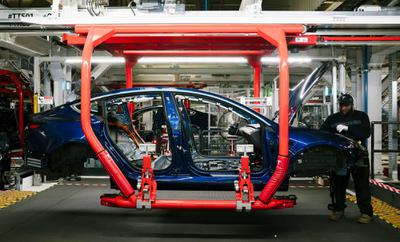To achieve net-zero emissions by 2050 the U.S. will need to triple renewable generation capacity.
In addition, Biden has set the goal of “net-zero emissions, economy-wide, by no later than 2050.” That’s what scientists tell us is needed to avoid the worst impacts of climate change. But getting there will eventually require all new passenger cars to be electric, all new buildings to have electric heat and hot water, and many other economic activities to switch from oil, natural gas, or coal to electricity. This will swell the demand for green power. A study released in October, the Zero Carbon Action Plan, found that to achieve net-zero emissions by 2050 the U.S. will need to increase renewable generation capacity from the current 1,100 gigawatts to 3,000 gigawatts. That means adding an average of 100 gigawatts every year between now and 2050, mostly from wind and solar. (A good-sized nuclear power plant has a capacity of about 1 gigawatt; most big wind and solar farms are less than half that size.)
Biden also is unlikely to get much help from Congress. Even if Democrats win both seats in the January 5 runoff election in Georgia, the resulting Democratic majority — a 50-50 split with tie-breaking votes cast by Vice President Kamala Harris — will likely be too fragile to achieve the strong actions sought by climate advocates, such as a nationwide clean electricity standard, an economy-wide price on carbon, elimination of fossil fuel subsidies, and a massive infusion of federal dollars into the clean-energy sector.
Notwithstanding all of this, there is a great deal the Biden administration will be able to do to advance clean electricity. And fortunately, the federal government will not have to do all the work. A total of 30 states plus the District of Columbia and Puerto Rico have “renewable portfolio standards” — requirements that electric utilities obtain a certain amount of their power from renewable sources — and nine of these require 100 percent clean electricity, mostly by 2050. These standards will even drive up renewable power generation in states that do not have such standards but want to sell power to states that do. Many cities have adopted similar goals. At least 260 major corporations have pledged to buy 100 percent renewable electricity. And the economics and popularity of renewables are improving so rapidly that entrepreneurs and investors are crowding the field, with record levels of private sector investment in U.S. renewable energy and grid technologies in 2019.
The Block Island Wind Farm, the first and only offshore wind facility in the U.S., located off the coast of Rhode Island. USDOE
Here are some of the key steps the Biden administration can take to bring the country closer to the goal of greening the electricity supply.
Federal lands and waters
The federal government owns vast swaths of land in the western states, including plenty that is suitable for the large number of wind and solar facilities we’ll need. Most of this is administered by the Bureau of Land Management (BLM). BLM can speed up the leasing of this land for renewables and charge lower rents, while also slowing down leasing for coal, oil, and natural gas extraction. Renewables development on federal lands is often delayed by the worthwhile but often protracted processes under the National Environmental Policy Act and the Endangered Species Act. Rather than conducting separate reviews for each project, this process can be sped up by undertaking regional environmental and species studies, which allows individual projects in the covered region to be approved much more quickly. The Obama administration did this successfully with the Western Solar Plan, an initiative that identified 19 zones suitable for solar farms across 285,000 acres in six states.
Offshore areas are controlled by the Bureau of Ocean Energy Management (BOEM). Under President Trump, who has been hostile to wind energy, BOEM has moved very slowly to approve some offshore wind projects. This can be accelerated, and BOEM should also open up more offshore areas for renewables leasing. The recent auctions of such leases off the coasts of Massachusetts and Long Island have been met with enthusiastic responses from the wind industry, with numerous bidders and record-setting bids.
The Biden administration can also make more effective use of a 2015 statute called the FAST Act, which provides for better coordination among federal agencies reviewing infrastructure projects, including renewable energy installations, and can hold agencies accountable if they do not meet review deadlines.
The Biden administration could mandate that the government shift its sources of electricity to renewables wherever possible.
The Federal Energy Regulatory Commission
During the Trump administration, FERC has taken several actions that favor fossil fuel generation over renewables. Among them are orders requiring certain wholesale electricity market operators to, in effect, require renewable energy companies to bid at auctions at artificially high prices, allowing fossil fuel generators to outbid them. FERC has also changed the rules under the Public Utility Regulatory Practices Act in a way that harms distributed renewable energy resources, and the commission has approved natural gas infrastructure without considering its climate impacts.
Depending on the timing of Senate confirmations and the possibility of early retirements, President Biden should be able to secure a Democratic majority on FERC by mid-2021. FERC could then reverse these actions and also reiterate that it will approve carbon pricing in the wholesale electricity markets if proposed by regional market operators. FERC could also give clearer guidance to these operators to encourage distributed energy resources, energy storage, and what is known as demand response, which for example allows utilities to change the settings on air conditioners and reduce power to certain appliances in participating households during peak demand.
Transmission lines
Large wind and solar farms are likely to be in remote areas where there is ample land and little local opposition. Bringing the power to the places where it is needed requires transmission lines. States control the siting of these lines, and often resist new lines that they feel do not sufficiently benefit them. To address this problem, Congress enacted a law in 2005 that granted the Department of Energy the authority to designate “national interest electric transmission corridors” where new lines are needed, and it gave FERC authority to override state inaction on lines in these corridors. Court decisions found that the Department of Energy had followed the wrong procedures in designating these corridors, and the courts also narrowly interpreted FERC’s authority. So this law has been ineffective, largely failing to speed up expansion of transmission lines.
Transmission lines at the 392-megawatt Ivanpah Solar Project, located on public lands in the Mojave Desert in California. Dennis Schroeder/NREL
As shown in a report about to be issued by Columbia’s Center for Global Energy Policy and New York University’s Institute for Policy Integrity, the law can and should be revived. By following the correct procedures, the Department of Energy can make new corridor designations, and FERC can issue a broader interpretation of the statute in most states, paving the way for the construction of additional transmission lines.
In 2010, FERC issued a directive, known as Order No. 1000, designed to encourage regional planning of transmission lines in a way that advances public policy goals, such as fighting climate change. Implementation of this order has gone poorly, but can be improved without Congressional action.
Procurement
The federal government annually purchases 54 terawatt hours of electricity, about the same as used by Greece. Only 10 percent of this is from renewables. The Biden administration could mandate that the government shift its sources of supply to renewables wherever possible. Federal agreements to purchase power could help new renewable facilities obtain financing.
By using financial levers, the Biden administration could hasten the transition to a decarbonized electricity sector.
The federal government also buys vast numbers of vehicles, computers, and appliances, and occupies 2.8 billion square feet of space. If the government insisted on procuring only the most energy-efficient equipment and on maximizing the energy efficiency of its space (and put solar panels on as many of its rooftops as possible), that would create markets for energy-efficient items and narrow the gap between supply and demand for renewables.
Tariffs
The Trump administration imposed tariffs on the importation of several types of equipment that are important for renewables. While the tariffs on solar panels benefited a few U.S. manufacturers, the Solar Energy Industries Association says by increasing prices on solar arrays, the tariffs cost more than 62,000 U.S. jobs and $19 billion in private sector investment. Tariffs imposed on wind towers in 2020 are likewise expected to harm the wind industry. A Trump order restricting the importation of “bulk-power system electric equipment” — such as control systems, large generators, capacitors, and transformers — on cybersecurity grounds is also causing concern in the energy storage industry, among others.
The Biden administration can revisit or rescind these orders that may inhibit renewables growth.
R&D
Biden has vowed to create an Advanced Research Projects Agency (ARPA-C) to develop technologies for clean energy such as grid-scale electricity storage, small modular nuclear reactors, zero net-energy buildings, use of renewables to produce carbon-free hydrogen, and carbon capture and storage or reuse. The benefits of federal investments in these technologies won’t be immediate, but they could be massive.
A Tesla Model 3 electric car being built in Fremont, California in 2018. Mason Trinca/The Washington Post/Getty Images
Financial regulation
The Dodd-Frank Wall Street Reform and Consumer Protection Act of 2010 empowers the Treasury Department, the Federal Reserve, and the Securities and Exchange Commission to limit systemic risks to financial stability. Today, of course, the impacts of climate change represent a growing threat to the economy. In September, the Commodity Futures Trading Commission issued a report stating that “climate change poses a major risk to the stability of the U.S. financial system and to its ability to sustain the American economy.” Last month, the Federal Reserve formally highlighted the risks that climate change poses to financial stability. Janet Yellin, who has been warning about the risks of climate change since at least 1997, has been nominated for Secretary of the Treasury.
These recent developments may lend credence to the suggestion by some climate advocates that the Biden administration could use Dodd-Frank to inhibit or prohibit investments in fossil fuels and related infrastructure, such as proposed natural gas pipelines and natural gas-fired power plants. A January report argued that climate risks could be grounds for financial regulators to require bank holding companies, insurers, and asset managers to divest from companies that engage in deforestation or cause high emissions. By using the federal government’s many financial levers, the Biden administration could further hasten the transition to a decarbonized electricity sector.
These are just some of the tools that Biden and his team will possess to advance clean electricity sources. This is in addition to revoking the numerous Trump-era actions that favored fossil fuels and to the many other mechanisms available under current law to reduce emissions from the power, motor vehicle, oil and gas, and other sectors of the economy. The absence of a cooperative Congress would make the job much more difficult, but there is still a great deal that can be done.






